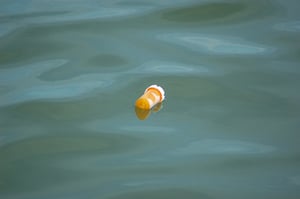
Water pollution isn’t a new issue, but the widespread impact of pharmaceutical and personal care product (PPCP) pollution has grown more worrisome as consumer habits have changed. While treated and potable waters have long contained chemicals and medications in minuscule amounts, the increase in pharmaceutical use is leading to greater concentrations. High levels of compounds originating from PPCPs have serious health and environmental repercussions.
From medications and antibiotics to lotions and fragrances, PPCPs are part of our everyday lives, and our consumption has consequences. Humans are one of the main contributors to PPCP pollution because we are unable to fully digest and absorb these products. We’re left to excrete or wash them down the drain. We even commonly flush unused pharmaceuticals to dispose of them.
Farms are another source of this type of pollution. Livestock are often treated with antibiotics delivered through their food and water, which can easily escape into surrounding waterways. Tainted water is nothing new, but with new livestock drugs on the market, and in higher demand than ever before, this type of pollution is on the rise and having major consequences.
Cause for Concern
Pharmaceuticals impact ecosystems in various ways. At the turn of the century, the anti-inflammatory and arthritis drug, diclofenac, used in both human and veterinary medicines, decimated vulture populations in South Asia. Cow and oxen were given the drug and the millions of vultures that consumed their medicated carcasses died. Once 90% of vultures disappeared, feral dog and plague-infested rat populations exploded. This disaster demonstrates the domino effect that introducing new medications in livestock can have on wildlife.
Other abnormalities have been tracked in aquatic life with species of fish showing the biologically altering effects of foreign chemicals in the water. In 2014, the Washington Post published an article about the discovery of intersex fish— male fish producing eggs. This article described the changes in Chesapeake Bay-area bass and white suckerfish, but also mentioned that intersex bass were found nationwide by the United States Geological Survey. Of course, this widespread phenomenon raises concerns about how humans can be impacted.
Our increased ingestion of antibiotics has inadvertently created “superbugs,” bacteria that resist typical drug treatments. Dr. Marie-Paule Kieny, the World Health Organization’s Assistant Director-General for Health Systems and Innovation, has even stated, “Antibiotic resistance is growing, and we are fast running out of treatment options.” Of course, there’s no single PPCP, farm or manufacturer to blame; scientists believe it’s the complex mixture of substances that are being brought together that are the root of these peculiarities.
Searching for a Solution
Some of the PPCP contaminants in U.S. waters include “the pain reliever naproxen, the sex hormone estrone and the anti-cholesterol drug byproduct clofibric acid,” all found in treated drinking water by a Tulane University researcher and his students. While wastewater treatment plants are indeed required to reduce regulated contaminants to a safe level, PPCPs can get into water sources that aren’t treated and aren’t yet regulated.
The Safe Drinking Water Act provides regulation for public drinking water, but PPCP contaminants are not yet regulated by the EPA. This could largely be because many of the substances resist treatment and “the EPA says there are no sewage treatment systems specifically engineered to remove pharmaceuticals,” reports the Associated Press. Without regulation in place, it’s difficult to know if, when and how the PPCP pollution problem will be addressed.
Final Notes
On a global level, more research into the abnormalities in both human and wildlife health will help identify the most problematic PPCPs and potentially influence industry-wide change within pharmaceuticals and farming. Regulatory bodies may also be encouraged to be proactive and assist with putting these industries on a more environmentally conscious trajectory. Although wildlife changes don’t necessarily indicate human ones are on the horizon, the long term effects of PPCP pollution may catch up with us in the future and the reality of superbugs shouldn’t be overlooked. Despite the gravity of the issue, there are ways everyone can help curb PPCP pollution. Non-profit American Rivers provides tips to follow here:
Photo courtesy of Ketzirah Lesser & Art Drauglis via Flickr (CC BY-SA 2.0)
https://e360.yale.edu/features/as_pharmaceutical_use_soars_drugs_taint_water_and_wildlife
https://www.health.harvard.edu/newsletter_article/drugs-in-the-water
http://www.nbcnews.com/id/26662637/ns/health-health_care/t/million-us-have-drugs-drinking-water/#.Wl02gJM-fow
https://www.thebureauinvestigates.com/stories/2017-05-06/big-pharmas-pollution-is-creating-deadly-superbugs-while-the-world-looks-the-other-way

